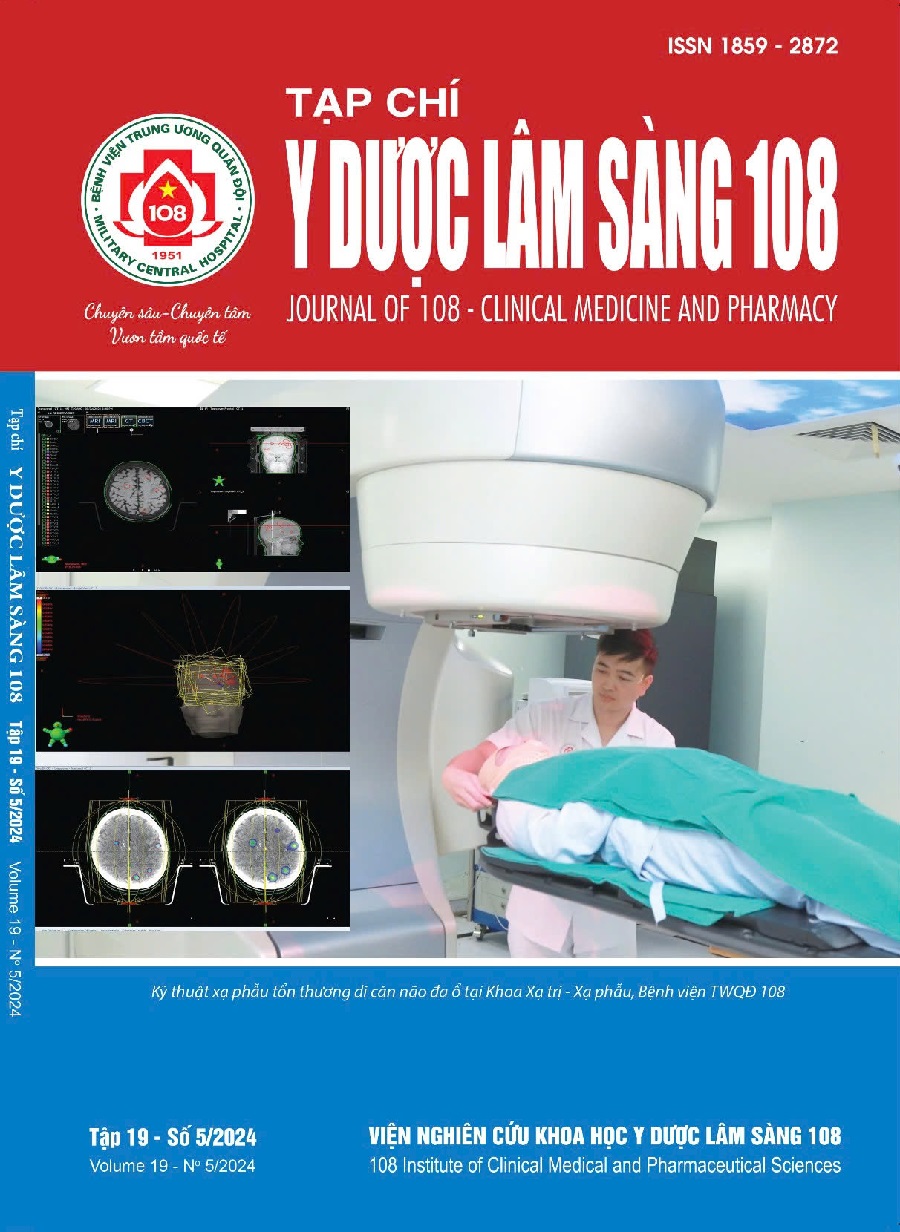Báo cáo trường hợp loạn dưỡng chất trắng trên bệnh nhân suy tuyến thượng thận có yếu tố gia đình được chẩn đoán và điều trị tại Bệnh viện Trung ương Quân đội 108
Main Article Content
Keywords
Tóm tắt
Loạn dưỡng chất trắng thượng thận (Adrenoleukodystrophy – ALD) liên kết giới tính là một rối loạn di truyền xảy ra chủ yếu ở nam giới, ảnh hưởng đến hệ thần kinh và tuyến thượng thận3, 7. Một bệnh nhân nam 37 tuổi có tiền sử mắc bệnh suy tuyến thượng thận năm 23 tuổi, hiện duy trì thường xuyên hydrocortisone 10mg ´ 2 viên/ngày. Lần này vào viện với các triệu chứng yếu tứ chi, đi lại khó khăn, nói khó, nuốt khó. Kết quả cận lâm sàng cho thấy axit béo chuỗi rất dài tăng, định lượng cortisol giảm, hình ảnh cộng hưởng từ não có tổn thương kiểu hủy myelin bán cầu tiểu não, cầu não, cuống đại não và đồi thị đối xứng hai bên. Bệnh nhân được chẩn đoán loạn dưỡng chất trắng thượng thận và điều trị chế độ giảm chất béo, điều chỉnh hormone tuyến thượng thận và phục hồi chức năng. Các triệu chứng lâm sàng của bệnh có cải thiện.
Article Details
Các tài liệu tham khảo
2. Zhu J, Eichler F, Biffi A, Duncan CN, Williams DA, Majzoub JA (2020) The Changing Face of Adrenoleukodystrophy. Majzoub Endocr Rev 41(4): 577-593.
3. Benjelloun FZM, Kriouile Y, Cheillan D, Daoud-Tetouani H, Chabraoui L (2017) Management of X-linked adrenoleukodystrophy in Morocco: Actual situation. BMC Res Notes 10: 567.
4. Wiesinger C, Eichler FS, Berger J (2015) The genetic landscape of X-linked adrenoleukodystrophy: Inheritance, mutations, modifier genes, and diagnosis. Appl Clin Genet 8: 109-121.
5. Watkiss E, Webb T, Bundey S (1993) Is skewed X inactivation responsible for symptoms in female carriers for adrenoleucodystrophy. J Med Genet 30(8): 651-654.
6. Del Mastro RG, Bundey S, Kilpatrick MW (1990) Adrenoleucodystrophy: A molecular genetic study in five families. J Med Genet 27(11): 670-675.
7. Mallack EJ, Turk BR, Yan H, Price C, Demetres M, Moser AB, Becker C, Hollandsworth K, Adang L, Vanderver A, Van Haren K, Ruzhnikov M, Kurtzberg J, Maegawa G, Orchard PJ, Lund TC, Raymond GV, Regelmann M, Orsini JJ, Seeger E, Kemp S, Eichler F, Fatemi A (2021) MRI surveillance of boys with X-linked adrenoleukodystrophy identified by newborn screening: Meta-analysis and consensus guidelines. J Inherit Metab Dis 44(3): 728-739.
8. Honey MIJ, Jaspers YRJ, Engelen M, Kemp S, Huffnagel IC (2021) Molecular biomarkers for adrenoleukodystrophy: an unmet need. Cells 10(12): 3427.
9. Ryalls MR, Gan HW, Davison JE (2021) Adrenoleukodystrophy in the differential diagnosis of boys presenting with primary adrenal insufficiency without adrenal antibodies. J Clin Res Pediatr Endocrinol 13(2): 212-217.
10. Ronghe M, Barton J, Jardine P, Crowne E, Webster M, Armitage M, Allen J, Steward C (2022) The importance of testing for adrenoleucodystrophy in males with idiopathic Addison's disease. Arch Dis Child 86(3): 1850189.
11. Salsano E, Tabano S, Sirchia SM, Colapietro P, Castellotti B, Gellera C, Rimoldi M, Pensato V, Mariotti C, Pareyson D, Miozzo M, Uziel G (2012) Preferential expression of mutant ABCD1 allele is common in adrenoleukodystrophy female carriers but unrelated to clinical symptoms. Orphanet J Rare Dis. 7: 10.
 ISSN: 1859 - 2872
ISSN: 1859 - 2872
